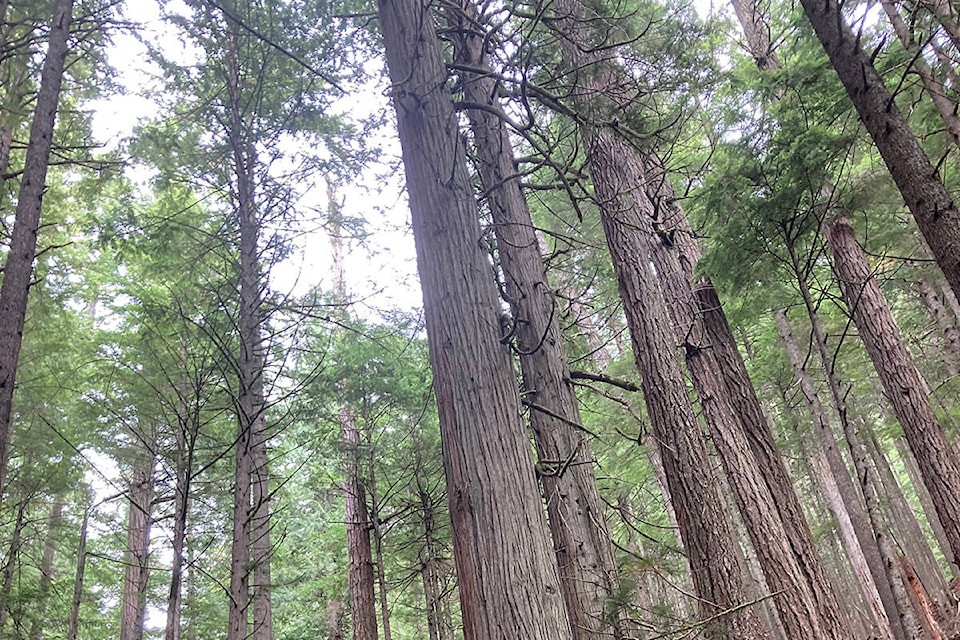A new report from the Canadian Parks and Wilderness Society British Columbia found the province’s Old Growth Management Areas “do not meet conservation standards and contain little old growth.”
The report found the actual composition of these areas, called OGMAs, are mostly (58 per cent) made up of young forest, with old forests (roughly 141 to 250 years, depending on the kind of forest), making up just under one third of the total area protected by Old Growth Management Areas. The remaining 13 per cent is either not forested (12 per cent), or does not have sufficient data (1 per cent).
“When broken down into individual OGMAs, 37 per cent of the approximately 22,000 legal OGMAs in B.C. do not contain any old forest,” the report says. “Active cutblocks overlap 27,300 hectares of legal OGMAs in the province, an area 68 times larger than Stanley Park.”
The report looked specifically at OGMAs in the Campbell River Resource District. CPAWS-BC found “frequent boundary changes to permit logging, and fragmented areas that cannot foster biodiversity.”
“We’ve known for a while that OGMAs are poorly protected but these results were just shocking and show how far off conservation standards these protections are,” says Meg Bjordal, author of the report and the conservation research and policy coordinator at CPAWS-BC. “Looking at these OGMA examples, between the data, satellite views and on-the-ground pictures, this is a black mark on B.C.’s progress to protect endangered ecosystems. It is devastating that we’re still destroying old growth forests.”
In December, 2022, the province committed to protecting 30 per cent of lands by the end of the decade in an effort to stop and reverse biodiversity loss.
According to the province, 19.6 per cent of B.C. is currently protected. That includes 15.5 per cent as protected areas including parks, conservancies and ecological reserves. The other 4.1 per cent is in a category called “Other Effective Conservation Measures (OECMs).”
OECMs in the province are further split into three designations: OGMAs, Wildlife Habitat Areas, and Wildland Zones. OGMAs are the largest proportion of these, at about 37 per cent. However, according to a , CPAWS and Ecojustice found that these designations do not meet Canadian or international standards. This includes the areas being designated as “rotating reserves.”
“This means that even under the spatial model, at some point in time they will be harvested,” said Justice Emily Burke in a 2021 Supreme court decision where the Blueberry River First Nation alleged that the province had infringed on its treaty rights based on cumulative effects of development within its territory. The court ruled in favour of the Blueberry River First Nation.
CPAWS recommends that the province amend the OGMA guidelines to ensure old growth is protected, conduct a provincial review of OGMAs and reform laws to ensure boundary changes and industrial activity cannot take place in the protected areas.
“Old Growth Management Areas are evidently falling short as a tool to foster biodiversity in B.C. forests and protect at-risk old growth,” the report says. “OGMAs must be improved to effectively protect old growth and meet standards to count towards biodiversity targets.”
The Ministry of Forests responded to the report, saying that “it is correct that many Old Growth Management Areas (OGMAs) contain more mature forests than old growth. However, mature forests were included in OGMAs to capture larger, more contiguous areas.”
The ministry also said in an emailed statement that since the 2021 assessment used in the CPAWS-BC report, “B.C. has paused further reporting on Other Effective Conservation Measures (OECMs) and will be developing a new assessment approach in collaboration with First Nations.
“The Province is reviewing and strengthening OGMA management as part of its improvement of forest management across B.C. Factors including a changing climate, insect outbreaks and wildfires are all important reasons for reviewing the policies that help us manage our old forests,” the ministry says. “The new $1 billion Nature Agreement, the $300-million Conservation Finance Mechanism, and the Biodiversity Ecosystem Health Framework are all significant steps towards achieving that goal.”
“Also, as the Province initiates more forest landscape plans, we are establishing clear objectives for developing permanent approaches to managing old growth and biodiversity, climate change and wildfire risk,” it says. “This includes incorporating OGMAs into long term strategies for old growth management.”
RELATED:




